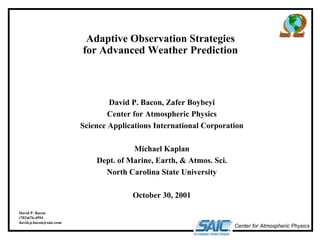
Advanced weatherpredictionoct01
- 1. Adaptive Observation Strategies for Advanced Weather Prediction Center for Atmospheric Physics David P. Bacon, Zafer Boybeyi Center for Atmospheric Physics Science Applications International Corporation Michael Kaplan Dept. of Marine, Earth, & Atmos. Sci. North Carolina State University October 30, 2001 David P. Bacon (703)676-4594 david.p.bacon@saic.com
- 2. Weather Forecasting – A Primer Center for Atmospheric Physics • Weather forecasting relies on a system of systems: – In-situ observations (surface, balloon, & aircraft) – Remotely-sensed observations (satellite-based) – Data assimilation (creating a physically consistent 3-D dataset) – Prognostic models (extrapolation into 4-D)
- 3. Center for Atmospheric Physics In-situ Observations • Irregular spatial distribution – Where the people (and planes) are • Quasi-regular temporal distribution – Surface observations » Hourly with special reports for significant weather – Balloon observations » Twice-daily at 0000Z & 1200Z – Aircraft observations » Regular intervals
- 4. Remote Sensing Observation Strategies Center for Atmospheric Physics • The beginning: – TIROS-1 (April 1, 1960) » Television and InfraRed Operational Satellite – ATS-1 (December 6, 1966) » Applications Technology Satellite – Geostationary » Communications system test bed • Raster based systems – Vidicon tubes to CCDs
- 5. Center for Atmospheric Physics Data Assimilation • Goal: A physically consistent 3-D representation of the atmosphere at an instant of time • Requirements: Rationalize a disparate set of data that is a mix of irregular and grid point information at synoptic (0000Z & 1200Z) and asynoptic times • Modify large-scale effects to reflect small-scale features – Capture steep gradients critical to severe weather
- 6. Center for Atmospheric Physics Prognostic Models • Most models are based on a rectangular grid structure – Intuitively obvious – Simplest tiling – Simple operator decomposition • Higher resolution is obtained by nesting – Conceptually easy – Numerically tricky » Reflective internal boundaries » Differing surface conditions » Scale interactive information exchange • Initial conditions obtained from data assimilation system – Generally at synoptic times
- 7. Center for Atmospheric Physics A Vicious Circle • Increased horizontal (α) and vertical (β) resolution in models leads to: – Higher resolution initial conditions: α2β – Increased run-time: α2β – Increased output volume: α2β max(αααα,,,, ββββ) • Higher resolution ICs requires higher resolution observations
- 8. Dynamic Adaptation of Data Assimilation Center for Atmospheric Physics and Model Resolution • Initial grid for an OMEGA simulation of Hurricane Floyd and the grid (inset) at 72 hours
- 9. OMEGA Forecast of Hurricane Floyd Center for Atmospheric Physics
- 10. Center for Atmospheric Physics Control Simulation • Initialization: – 1200Z September 13 – NOGAPS Analysis • Boundary Conditions: – NOGAPS Forecast • Grid Resolution: – 5 - 15 km
- 11. Verification of Control Simulation • Storm Tracks – White: Observations – Red: Control Center for Atmospheric Physics
- 12. Center for Atmospheric Physics Coarse Resolution Simulation • Initialization: – 0000Z September 14 – NOGAPS Analysis • Boundary Conditions: – NOGAPS Forecast • Grid Resolution: – 75 - 120 km
- 13. Verification of Coarse Resolution Simulation • Storm Tracks – White: Observations – Red: Control – Yellow: Coarse Res • Significant westward track deviation Center for Atmospheric Physics
- 14. Center for Atmospheric Physics Adaptive Observations • Control Run provides a source of pseudo-observations for OSSEs • Control cell centroid closest to the Coarse cell centroid used to provide pseudo-sounding
- 15. Case #1: 654 Targeted Observations • Coarse Resolution Configuration • Added 654 observations – All cell centroids in box around storm Center for Atmospheric Physics
- 16. Verification of Case #1 (654 Targeted Observations) • Storm Tracks – White: Observations – Red: Control – Yellow: Coarse Res – Orange: Case #1 (654) • Noticeable improvement in forecasted track Center for Atmospheric Physics
- 17. Case #2: 100 Targeted Observations • Coarse Resolution Configuration • Added 100 observations – Regular 10 x 10 array around storm • Storm Tracks – White: Observations – Red: Control – Yellow: Coarse Res – Orange: Case #1 (654) – Green: Case #2 (100) • Virtually identical track to Case #1 with only 20% of the targeted observations Center for Atmospheric Physics
- 18. Case #3: 11 Targeted Observations • Coarse Resolution Configuration • Added 11 observations – Around initial storm location • Storm Tracks – White: Observations – Red: Control – Yellow: Coarse Res – Cyan: Case #3 (11) • Very minor difference from Coarse resolution simulation Center for Atmospheric Physics
- 19. Case #4: 50 Targeted Observations • Coarse Resolution Configuration • Added 50 observations – Along forecasted track • Storm Tracks – White: Observations – Red: Control – Yellow: Coarse Res – Pink: Case #4 (50) • While this case improved the forecast early on, it did not improve the track at later times as much as Case #1 or Case #2 Center for Atmospheric Physics
- 20. Case #5: 25 Targeted Observations • Coarse Resolution Configuration • Added 50 observations – Along forecasted track • Storm Tracks – White: Observations – Red: Control – Yellow: Coarse Res – Cyan: Case #5 (25) • Track nearly identical to Case #4. Center for Atmospheric Physics
- 21. Center for Atmospheric Physics Conclusions and Ramifications • Targeted observations can have a dramatic impact on storm forecasts – Improvement in initial storm conditions has the largest payoff – Other scenarios may have different requirements • Greatest improvement will come in identifying and obtaining key observations for developing convective storms – The critical scales are so small and hence the volume of regular arrays of observations is so large that either the communications become a dominant problem or the extraction of a “signal” from the “noise” of data bits prevents utilization • The routine utilization of targeted as opposed to general satellite observations has significant impact on satellite operations – Timeliness is key ⇒Communication & data mining issues • A tightly linked forecast and observational system can address these issues as well
